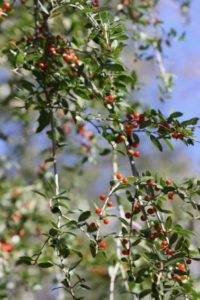

by Lydia Holley December 6, 2021
If you live in East Texas, more than likely you have a yaupon holly in your garden. Many grow the dwarf shrub as a boxwood substitute. It is evergreen and grows slowly, so a yearly hedging is usually all that is required. Because the most common cultivar of this particular shrub is propagated from a male plant, they bear no fruit. Unlike shrubs, yaupon trees are usually purchased in anticipation of it producing red berries, so these are propagated from the females.
Yaupons take well to shaping into topiary. The shape most often used is like a wide-open umbrella or something taller and less wide, reminiscent of a popsicle. You can try other shapes if you so desire. Of course, you can also leave the tree in its natural form.
If you like the shape of Italian cypresses, there are several cultivars of yaupon holly which grow in a columnar shape. Tall and thin, these types are perfect to fit into narrow spaces where you want something that grows to a great height. Although these columnar cultivars only spread to around three feet, they can reach from 15 to 25 ft. tall.
In my own garden, one of my favorite trees is a weeping yaupon. When I was young, the neighbors had a weeping willow. I thought it was the most beautiful tree, and I saved my allowance for months to purchase one for our yard. Looking back, my parents were less enthusiastic about this tree being added to their landscape, and it didn’t live long. I still love trees with weeping forms, and since yaupons are native to East Texas, weeping yaupon is easy to grow. Yaupons will grow in sun or shade, dry or moist soil.
Whether you choose to grow a yaupon in its natural state, shape it into a topiary, or select a
dwarf, columnar, or weeping form, these plants are worth adding to your garden.
For more information, call 903-675-6130, email hendersonCMGA@gmail.com.
Follow us on Facebook: https://www.facebook.com/HCmastergardener.